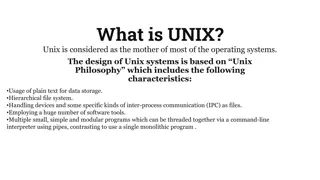Understanding the Make Utility in Linux/Unix Operating Systems
The Make utility in Linux/Unix is a command generator designed to assist in compiling large projects efficiently by using Makefiles with rules and dependencies to determine and execute necessary tasks. It minimizes recompilation, reduces resource usage, and streamlines complex program compilation processes.
Download Presentation

Please find below an Image/Link to download the presentation.
The content on the website is provided AS IS for your information and personal use only. It may not be sold, licensed, or shared on other websites without obtaining consent from the author. Download presentation by click this link. If you encounter any issues during the download, it is possible that the publisher has removed the file from their server.
E N D
Presentation Transcript
The make utility (original presentation courtesy of AlarkJoshi) Make is a utility that is included with Linux/Unix operating systems It is a command generator It is designed to help you compile large projects
What is make? Make is non-procedural You tell make what you want (e.g. a particular class file or executable) You provide a set of rules showing dependencies between files Make uses the rules to get the job done
Why use make? For large programs, recompiling all the pieces of the program can be very resource intensive But if the program is complex, determining exactly what needs to be recompiled can be a time-consuming (and error-prone) task The make utility was written to assist with this process
What does make do? Make uses a file called Makefile (or makefile) to determine what needs to be recompiled Makefile contains a set of rules When you run make, it uses the rules in the Makefile to determine what needs to be done Make does the minimum amount of work needed to get the job done
Rules in a Makefile A typical rule has the form target: dependency list command list target can be the name of a file that needsto be created (or a phony name that can be used to specify which commandto execute) The dependencylist is a spaceseparatedlist of files that the target dependson in someway The command list is one or more linux commands neededto accomplishthe task of creatingthe target
Rules in a Makefile Each command must be indented with a tab Both dependency lists and commands can be continued onto another line by putting a \ at the end of the first line A # is used to start a comment in a makefile The comment consists of the remainder of the line
Example Dependencies for a list program: TestList.c includes List.h, Node.h, Job.h, and common.h List.c includes List.h, Node.h, Job.h, and common.h Node.c includes Node.h, Job.h, and common.h Job.c includes Job.h and common.h
Rules for the list program Brute-force approach
How make works When you type make without a target name will assume you mean to make the first real target in the makefile When you type make target, the make utility will look at the rule for target make will recursively search through the rules for all the dependencies to determine what has been modified
How make works If the current version of target is newer than all the files it depends on, make will do nothing. If a target file is older than any of the files that it depends on, the command following the rule will be executed
Macros Sometimes, you find yourself using the same stuff in lots of command actions---macros simplify things Define macro CC = gcc CFLAGS = -O Wall g PROGS = list TestList Then use the macro by typing $(macroname) $(CC) $(CFLAGS) c List.c
# File "makefile" used to build "ola207" executable CXX = g++ -std=c++11 pedantic ola207: bakery.o bakeryPrint.o $(CXX) -g bakery.o bakeryPrint.o -o ola207 bakery.o: bakery.cpp bakeryPrint.h bakeryConstants.h $(CXX) -g -c bakery.cpp bakeryPrint.o: bakeryPrint.cpp bakeryPrint.h bakeryConstants.h $(CXX) -g -c bakeryPrint.cpp
Phony Targets Phony targets are targets that do not correspond to a file clean: rm f *.o
Example all: subdirs subdirs: cd bad; make cd almost-generic; make cd generic-with-library; make cd generic; make clean: cd bad; make clean cd almost-generic; make clean cd generic-with-library/; make clean cd generic; make clean
(Optional) Advanced Stuff follows:
Substitution Rules Often, you will find that your Makefile has many similar commands You can use patterns to define rules and commands for such cases For example, we could use the rule %.o : %.c $(CC) $(CFLAGS) c $< Which says that every .o file depends on the corresponding .c file and can be created from it with the command below the rule
Substitution Rules - Internal macros % - any name (the same in all occurrences) $@ - The name of the current target $< - The first dependency for the current target $^ - All the dependenciesfor the current target %.o : %.c $(CC) $(CFLAGS) c $< hello: $(CC) hello.o $(CFLAGS) $< -o $@
Suffix Rules A suffix rule identifies suffixes that make should recognizes .SUFFIXES: .o .c Another rule shows how files with suffixes are related .c.o : $(CC) $(CFLAGS) c $< Think of this as saying the .o file is created from the corresponding .c file using the given command
A More Advanced Example With macros, suffix rules and phony targets
Taking the drudgery out of dependencies Dependencies for a .o file should include all the user written header files that it includes For a big project, getting all of these right can take some time The gcc command has an option -MMD which tells it to computethe dependencies. These are stored in a file with the suffix .d Includethe .d file into the Makefile using -include *.d
Multiple rules for a target If there is more that one rule for a given target, make will combine them. The rules can be specified in any order in the Makefile























